Submitted:
22 May 2023
Posted:
23 May 2023
You are already at the latest version
Abstract
Keywords:
1. Introduction
2. Materials and Methods
2.1. Study Area and Sampling Design
2.2. Spectral Mixture Analysis and Remote Sensing Estimates of Windthrow Tree-Mortality
2.3. Remote Sensing Estimates of Windthrow Tree-Mortality
2.4. Statistical Analysis
3. Results
3.1. How Does Spatial Resolution Affect Satellite Estimates of Windthrow Tree-Mortality?
3.2. Which Sensor Produces the Most Reliable Estimates of Windthrow Tree-Mortality Across an Extent Gradient of Windthrow Severity?
4. Discussion
4.1. Relating Satellite Data and Field Data
4.2. Trade-Off between Precision and Accuracy of Satellite Estimates
5. Conclusions
Supplementary Materials
Author Contributions
Funding
Data Availability Statement
Acknowledgments
Conflicts of Interest
References
- Marra, D.M.; Chambers, J.Q.; Higuchi, N.; Trumbore, S.E.; Ribeiro, G.H.P.M.; Dos Santos, J.; Negrón-Juárez, R.I.; Reu, B.; Wirth, C. Large-Scale Wind Disturbances Promote Tree Diversity in a Central Amazon Forest. PLoS ONE 2014. [Google Scholar] [CrossRef]
- Magnabosco Marra, D.; Trumbore, S.E.; Higuchi, N.; Ribeiro, G.H.P.M.P.M.; Negrón-Juárez, R.I.; Holzwarth, F.; Rifai, S.W.; dos Santos, J.; Lima, A.J.N.N.; Kinupp, V.F.; et al. Windthrows Control Biomass Patterns and Functional Composition of Amazon Forests. Global Change Biology 2018, 24, 5867–5881. [Google Scholar] [CrossRef]
- Rifai, S.W.; Urquiza Muñoz, J.D.; Negrón-Juárez, R.I.; Ramírez Arévalo, F.R.; Tello-Espinoza, R.; Vanderwel, M.C.; Lichstein, J.W.; Chambers, J.Q.; Bohlman, S.A. Landscape-Scale Consequences of Differential Tree Mortality from Catastrophic Wind Disturbance in the Amazon. Ecological Applications 2016. [Google Scholar] [CrossRef] [PubMed]
- Urquiza Muñoz, J.D.; Magnabosco Marra, D.; Negrón-Juarez, R.I.; Tello-Espinoza, R.; Alegría-Muñoz, W.; Pacheco-Gómez, T.; Rifai, S.W.; Chambers, J.Q.; Jenkins, H.S.; Brenning, A.; et al. Recovery of Forest Structure Following Large-Scale Windthrows in the Northwestern Amazon. Forests 2021, 12, 667. [Google Scholar] [CrossRef]
- Belward, A.S.; Skøien, J.O. Who Launched What, When and Why; Trends in Global Land-Cover Observation Capacity from Civilian Earth Observation Satellites. ISPRS Journal of Photogrammetry and Remote Sensing 2015, 103, 115–128. [Google Scholar] [CrossRef]
- Negrón-Juárez, R.I.; Holm, J.A.; Marra, D.M.; Rifai, S.W.; Riley, W.J.; Chambers, J.Q.; Koven, C.D.; Knox, R.G.; McGroddy, M.E.; Di Vittorio, A. V.; et al. Vulnerability of Amazon Forests to Storm-Driven Tree Mortality. Environmental Research Letters 2018. [Google Scholar] [CrossRef]
- Negrón-Juárez, R.I.; Chambers, J.Q.; Guimaraes, G.; Zeng, H.; Raupp, C.F.M.; Marra, D.M.; Ribeiro, G.H.P.M.; Saatchi, S.S.; Nelson, B.W.; Higuchi, N. Widespread Amazon Forest Tree Mortality from a Single Cross-Basin Squall Line Event. Geophysical Research Letters 2010. [Google Scholar] [CrossRef]
- Nelson, B.W.; Amaral, I. Destructive Wind Effects Detected in TM Images of the Amazon Basin. Int. Arch. of Photg. and Rem. Sens. 1994, 30, 339–343. [Google Scholar]
- Negrón-Juárez, R.; Jenkins, H.; Raupp, C.; Riley, W.; Kueppers, L.; Magnabosco Marra, D.; Ribeiro, G.; Monteiro, M.; Candido, L.; Chambers, J.; et al. Windthrow Variability in Central Amazonia. Atmosphere 2017, 8, 28. [Google Scholar] [CrossRef]
- Negron-Juarez, R.; Magnabosco-Marra, D.; Feng, Y.; Urquiza-Muñoz, J.D.; Riley, W.J.; Chambers, J.Q. Windthrow Characteristics and Their Regional Association with Rainfall, Soil, and Surface Elevation in the Amazon. Environmental Research Letters 2023, 18, 014030. [Google Scholar] [CrossRef]
- Roy, D.P.; Wulder, M.A.; Loveland, T.R.; C. E., W.; Allen, R.G.; Anderson, M.C.; Helder, D.; Irons, J.R.; Johnson, D.M.; Kennedy, R.; et al. Landsat-8: Science and Product Vision for Terrestrial Global Change Research. Remote Sensing of Environment 2014, 145, 154–172. [Google Scholar] [CrossRef]
- Coppin, P.; Jonckheere, I.; Nackaerts, K.; Muys, B.; Lambin, E. Digital Change Detection Methods in Ecosystem Monitoring: A Review. International Journal of Remote Sensing 2004. [Google Scholar] [CrossRef]
- Goward, S.; Arvidson, T.; Williams, D.; Faundeen, J.; Irons, J.; Franks, S. Historical Record of Landsat Global Coverage: Mission Operations, NSLRSDA, and International Cooperator Stations. Photogrammetric Engineering and Remote Sensing 2006.
- Woodcock, C.E.; Strahler, A.H. The Factor of Scale in Remote Sensing. Remote Sensing of Environment 1987, 21, 311–332. [Google Scholar] [CrossRef]
- Coops, N.C.; Wulder, M.A.; White, J.C. Identifying and Describing Forest Disturbance and Spatial Pattern: Data Selection Issues and Methodological Implications. In Understanding Forest Disturbance and Spatial Pattern; Wulder, M.A., Franklin, S.E., Eds.; CRC Press: Florida, 2006; pp. 31–61. [Google Scholar]
- Negrón-Juárez, R.I.; Chambers, J.Q.; Marra, D.M.; Ribeiro, G.H.P.M.; Rifai, S.W.; Higuchi, N.; Roberts, D. Detection of Subpixel Treefall Gaps with Landsat Imagery in Central Amazon Forests. Remote Sensing of Environment 2011. [Google Scholar] [CrossRef]
- Negrón-Juárez, R.I.; Holm, J.A.; Faybishenko, B.; Magnabosco-Marra, D.; Fisher, R.A.; Shuman, J.K.; de Araujo, A.C.; Riley, W.J.; Chambers, J.Q. Landsat Near-Infrared (NIR) Band and ELM-FATES Sensitivity to Forest Disturbances and Regrowth in the Central Amazon. Biogeosciences 2020, 17, 6185–6205. [Google Scholar] [CrossRef]
- Asner, G.P.; Kellner, J.R.; Kennedy-Bowdoin, T.; Knapp, D.E.; Anderson, C.; Martin, R.E. Forest Canopy Gap Distributions in the Southern Peruvian Amazon. PLoS ONE 2013. [Google Scholar] [CrossRef]
- Asner, G.P.; Keller, M.; Pereira, Jr, R. ; Zweede, J.C.; Silva, J.N.M. CANOPY DAMAGE AND RECOVERY AFTER SELECTIVE LOGGING IN AMAZONIA: FIELD AND SATELLITE STUDIES. Ecological Applications 2004, 14, 280–298. [Google Scholar] [CrossRef]
- Adams, J.B.; Gillespie, A.R. Remote Sensing of Landscapes with Spectral Images; Adams, J.B. , Gillespie, A.R., Eds.; 1st ed.; Cambridge University Press: New York, USA, 2006; ISBN 9780521662215. [Google Scholar]
- Turner, M.G. Landscape Ecology: The Effect of Pattern on Process. Annual Review of Ecology and Systematics 1989, 20, 171–197. [Google Scholar] [CrossRef]
- Wulder, M. Optical Remote-Sensing Techniques for the Assessment of Forest Inventory and Biophysical Parameters. Progress in Physical Geography: Earth and Environment 1998, 22, 449–476. [Google Scholar] [CrossRef]
- Townshend, J.R.G.; Justice, C.O. Selecting the Spatial Resolution of Satellite Sensors Required for Global Monitoring of Land Transformations. International Journal of Remote Sensing 1988, 9, 187–236. [Google Scholar] [CrossRef]
- Asner, G.P.; Warner, A.S. Canopy Shadow in IKONOS Satellite Observations of Tropical Forests and Savannas. Remote Sensing of Environment 2003. [Google Scholar] [CrossRef]
- Clark, D.B.; Castro, C.S.; Alvarado, L.D.A.; Read, J.M. Quantifying Mortality of Tropical Rain Forest Trees Using High-Spatial-Resolution Satellite Data. Ecology Letters 2004, 7, 52–59. [Google Scholar] [CrossRef]
- Clark, D.B.; Read, J.M.; Clark, M.L.; Cruz, A.M.; Dotti, M.F.; Clark, D.A. APPLICATION OF 1-M AND 4-M RESOLUTION SATELLITE DATA TO ECOLOGICAL STUDIES OF TROPICAL RAIN FORESTS. Ecological Applications 2004, 14, 61–74. [Google Scholar] [CrossRef]
- Dalagnol, R.; Phillips, O.L.; Gloor, E.; Galvão, L.S.; Wagner, F.H.; Locks, C.J.; Aragão, L.E.O.C.O.C. Quantifying Canopy Tree Loss and Gap Recovery in Tropical Forests under Low-Intensity Logging Using VHR Satellite Imagery and Airborne LiDAR. Remote Sensing 2019. [Google Scholar] [CrossRef]
- Fuller, D.O. Tropical Forest Monitoring and Remote Sensing: A New Era of Transparency in Forest Governance? Singapore Journal of Tropical Geography 2006, 27, 15–29. [Google Scholar] [CrossRef]
- Jackson, C.; Adam, E. Remote Sensing of Selective Logging in Tropical Forests: Current State and Future Directions. iForest - Biogeosciences and Forestry 2020, 13, 286–300. [Google Scholar] [CrossRef]
- Espírito-Santo, F.D.B.; Keller, M.M.; Linder, E.; Oliveira Junior, R.C.; Pereira, C.; Oliveira, C.G. Gap Formation and Carbon Cycling in the Brazilian Amazon: Measurement Using High-Resolution Optical Remote Sensing and Studies in Large Forest Plots. Plant Ecology and Diversity 2014. [Google Scholar] [CrossRef]
- Espírito-Santo, F.D.B.; Gloor, M.; Keller, M.; Malhi, Y.; Saatchi, S.; Nelson, B.; Junior, R.C.O.; Pereira, C.; Lloyd, J.; Frolking, S.; et al. Size and Frequency of Natural Forest Disturbances and the Amazon Forest Carbon Balance. Nature Communications 2014. [Google Scholar] [CrossRef]
- Rehbein, A.; Ambrizzi, T.; Mechoso, C.R. Mesoscale Convective Systems over the Amazon Basin. Part I: Climatological Aspects. International Journal of Climatology, 2018. [Google Scholar] [CrossRef]
- IPCC Climate Change 2021: The Physical Science Basis. Contribution of Working Group I to the Sixth Assessment Report of the Intergovernmental Panel on Climate Change [Masson-Delmotte, V., P. Zhai, A. Pirani, S.L. Connors, C. Péan, S. Berger, N. Caud, Y. Chen, ; UK and USA, 2021.
- Feng, Y.; Negrón-Juárez, R.I.; Romps, D.M.; Chambers, J.Q. Amazon Windthrow Disturbances Are Likely to Increase with Storm Frequency under Global Warming. Nature Communications 2023, 14, 101. [Google Scholar] [CrossRef]
- Aleixo, I.; Norris, D.; Hemerik, L.; Barbosa, A.; Prata, E.; Costa, F.; Poorter, L. Amazonian Rainforest Tree Mortality Driven by Climate and Functional Traits. Nature Climate Change 2019. [CrossRef]
- Chambers, J.Q.; Negron-Juarez, R.I.; Marra, D.M.; Di Vittorio, A.; Tews, J.; Roberts, D.; Ribeiro, G.H.P.M.; Trumbore, S.E.; Higuchi, N. The Steady-State Mosaic of Disturbance and Succession across an Old-Growth Central Amazon Forest Landscape. Proceedings of the National Academy of Sciences 2013. [Google Scholar] [CrossRef] [PubMed]
- Esquivel-Muelbert, A.; Phillips, O.L.; Brienen, R.J.W.; Fauset, S.; Sullivan, M.J.P.; Baker, T.R.; Chao, K.J.; Feldpausch, T.R.; Gloor, E.; Higuchi, N.; et al. Tree Mode of Death and Mortality Risk Factors across Amazon Forests. Nature Communications 2020, 11, 1–11. [Google Scholar] [CrossRef] [PubMed]
- Gora, E.M.; Esquivel-Muelbert, A. Implications of Size-Dependent Tree Mortality for Tropical Forest Carbon Dynamics. Nature Plants 2021, 7, 384–391. [Google Scholar] [CrossRef] [PubMed]
- Telles, E. de C.C.; de Camargo, P.B.; Martinelli, L.A.; Trumbore, S.E.; da Costa, E.S.; Santos, J.; Higuchi, N.; Oliveira, R.C. Influence of Soil Texture on Carbon Dynamics and Storage Potential in Tropical Forest Soils of Amazonia. Global Biogeochemical Cycles 2003, 17, n. [Google Scholar] [CrossRef]
- Ferraz, J.; Ohta, S.; de Sales, P.C. Distribuição Dos Solos Ao Longo de Dois Transectos Em Floresta Primária Ao Norte de Manaus (AM). In Pesquisas florestais para a conservação da floresta e reabilitação de áreas degradadas da Amazônia; MCT-INPA/JICA, Ed.; INPA: Manaus, AM, 1998; pp. 109–143. [Google Scholar]
- Andreae, M.O.; Acevedo, O.C.; Araùjo, A.; Artaxo, P.; Barbosa, C.G.G.; Barbosa, H.M.J.; Brito, J.; Carbone, S.; Chi, X.; Cintra, B.B.L.; et al. The Amazon Tall Tower Observatory (ATTO): Overview of Pilot Measurements on Ecosystem Ecology, Meteorology, Trace Gases, and Aerosols. Atmospheric Chemistry and Physics 2015. [Google Scholar] [CrossRef]
- Stropp, J.; Sleen, P. Van der; Assunção, P.A.; Silva, A.L. da; Steege, H. Ter Tree Communities of White-Sand and Terra-Firme Forests of the Upper Rio Negro. Acta Amazonica 2011, 41, 521–544. [Google Scholar] [CrossRef]
- Targhetta, N.; Kesselmeier, J.; Wittmann, F. Effects of the Hydroedaphic Gradient on Tree Species Composition and Aboveground Wood Biomass of Oligotrophic Forest Ecosystems in the Central Amazon Basin. Folia Geobot 2015, 50, 185–205. [Google Scholar] [CrossRef]
- Oliveira, A.N. de; Amaral, I.L. do Florística e Fitossociologia de Uma Floresta de Vertente Na Amazônia Central, Amazonas, Brasil. Acta Amazonica 2004. [Google Scholar] [CrossRef]
- Luizão, F.J.; Schubart, H.O.R. Litter Production and Decomposition in a Terra-Firme Forest of Central Amazonia. Experientia 1987. [Google Scholar] [CrossRef]
- Almeida, A.F. de Análise fitossociológica estrutural e composição florística da área de proteção ambiental margem esquerda do rio Negro, Manaus-AM. Dissertação (Mestrado em Ciências Florestais e Ambientais), Universidade Federal do Amazonas: Manaus, Brazil, 2012.
- AMARAL, I.L. do; MATOS, F.D.A.; LIMA, J. Composição Florística e Parâmetros Estruturais de Um Hectare de Floresta Densa de Terra Firme No Rio Uatumã, Amazônia, Brasil. Acta Amazonica 2000, 30, 377–377. [Google Scholar] [CrossRef]
- Woortmann, C.P.I.B.; Higuchi, N.; Santos, J. dos; Silva, R.P. da; dos SANTOS, J.; da SILVA, R.P. Allometric Equations for Total, above-and below-Ground Biomass and Carbon of the Amazonian Forest Type Known as Campinarana. Acta Amazonica 2018, 48, 85–92. [Google Scholar] [CrossRef]
- Gorelick, N.; Hancher, M.; Dixon, M.; Ilyushchenko, S.; Thau, D.; Moore, R. Google Earth Engine: Planetary-Scale Geospatial Analysis for Everyone. Remote Sensing of Environment 2017, 202, 18–27. [Google Scholar] [CrossRef]
- Adams, J.B.; Sabol, D.E.; Kapos, V.; Almeida Filho, R.; Roberts, D.A.; Smith, M.O.; Gillespie, A.R. Classification of Multispectral Images Based on Fractions of Endmembers: Application to Land-Cover Change in the Brazilian Amazon. Remote sensing of Environment 1995, 52, 137–154. [Google Scholar] [CrossRef]
- Shimabukuro, Y.E.; Smith, J.A. The Least-Squares Mixing Models to Generate Fraction Images Derived from Remote Sensing Multispectral Data. IEEE Transactions on Geoscience and Remote Sensing 1991, 29, 16–20. [Google Scholar] [CrossRef]
- Ponzoni, F.J.; Shimabukuro, Y.E. ; Kuplich., T.M. Sensoriamento Remoto No Estudo Da Vegetação; Ponzoni, F.J., Shimabukuro, Y.E., Kuplich., T.M., Eds.; 2nd ed.; Oficina de Textos: São Paulo-SP, 2012; ISBN 978-85-7975-053-3. [Google Scholar]
- Somers, B.; Asner, G.P.; Tits, L.; Coppin, P. Endmember Variability in Spectral Mixture Analysis: A Review. Remote Sensing of Environment 2011, 115, 1603–1616. [Google Scholar] [CrossRef]
- Exelis Visual Solutions Information ENVI 5.3 2010.
- Green, A.A.; Berman, M.; Switzer, P.; Craig, M.D. A Transformation for Ordering Multispectral Data in Terms of Image Quality with Implications for Noise Removal. IEEE Transactions on Geoscience and Remote Sensing 1988, 26, 65–74. [Google Scholar] [CrossRef]
- Shimabukuro, Y.E.; Ponzoni, F.J. Mistura Espectral: Modelo Linear e Aplicações; Yosio Edemir Shimabukuro, F.J.P., Ed.; 1a.; Oficina de Textos, 2017; ISBN 978-85-7975-270-4.
- Uptike, T.; Comp, C. Radiometric Use of WorldView-2 Imagery. Available online: https://dg-cms-uploads-production.s3.amazonaws.com/uploads/document/file/104/Radiometric_Use_of_WorldView-2_Imagery.pdf (accessed on 11 May 2022).
- L3HARRIS Linear Spectral Unmixing. Available online: https://www.l3harrisgeospatial.com/docs/linearspectralunmixing.html (accessed on 19 January 2022).
- Nelson, B.W.; Kapos, V.; Adams, J.B.; Oliveira, W.J.; Braun, O.P.G.G. Forest Disturbance by Large Blowdowns in the Brazilian Amazon. Ecology 1994, 75, 853–858. [Google Scholar] [CrossRef]
- Adams, J.B.; Smith, M.O.; Gillespie, A.R. Imaging Spectroscopy: Interpretation Based on Spectral Mixture Analysis. In Remote geochemical analysis: Elemental and mineralogical composition; Pieters, V.M., Englert, P., Eds.; Cambridge University Press: New York, 1993; pp. 145–166. [Google Scholar]
- Souza, C.M.; Roberts, D.A.; Cochrane, M.A. Combining Spectral and Spatial Information to Map Canopy Damage from Selective Logging and Forest Fires. Remote Sensing of Environment 2005, 98, 329–343. [Google Scholar] [CrossRef]
- Chambers, J.Q.; Asner, G.P.; Morton, D.C.; Anderson, L.O.; Saatchi, S.S.; Espírito-Santo, F.D.B.; Palace, M.; Souza, C. Regional Ecosystem Structure and Function: Ecological Insights from Remote Sensing of Tropical Forests. Trends in Ecology and Evolution 2007. [CrossRef]
- Daldegan, G.A.; Roberts, D.A.; Ribeiro, F. de F. Spectral Mixture Analysis in Google Earth Engine to Model and Delineate Fire Scars over a Large Extent and a Long Time-Series in a Rainforest-Savanna Transition Zone. Remote Sensing of Environment 2019, 232, 111340. [Google Scholar] [CrossRef]
- Gao, Y.; Skutsch, M.; Paneque-Gálvez, J.; Ghilardi, A. Remote Sensing of Forest Degradation: A Review. Environ. Res. Lett 2020, 15, 103001. [Google Scholar] [CrossRef]
- QGIS Development Team QGIS Geographic Information System. Open Source Geospatial Foundation Project 2016.
- McCullagh, P.; Nelder, J.A. Generalized Linear Models.; McCullagh, P., Nelder, J.A., Eds.; 2nd. Ed.; Taylor & Francis Group: Florida, 1989; ISBN 0-412-31760-5. [Google Scholar]
- Hawkins, D.M. The Problem of Overfitting. Journal of Chemical Information and Computer Sciences 2004, 44, 1–12. [Google Scholar] [CrossRef] [PubMed]
- Murtaugh, P.A. In Defense of P Values. Ecology 2014, 95, 611–617. [Google Scholar] [CrossRef]
- Kullback, S. Information Theory and Statistics; Wiley, Ed.; Dover Publications: New York, USA, 1997; ISBN 0-486-69684-7.
- Cameron, A.C.; Windmeijer, F.A.G. An R-Squared Measure of Goodness of Fit for Some Common Nonlinear Regression Models. Journal of Econometrics 1997, 77, 329–342. [Google Scholar] [CrossRef]
- Gotelli, N.J.; Ellinson, A.M. A Primer of Ecological Statistics. Journal of Chemical Information and Modeling 2013. [Google Scholar] [CrossRef]
- Le Cam, L. The Central Limit Theorem around 1935. Statistical science 1986, 1, 78–91. [Google Scholar]
- R Core Team R Core Team (2022). R: A Language and Environment for Statistical Computing. R Foundation for Statistical Computing 2022.
- Goel, N.S.; Strebel, D.E.; Thompson, R.L. Inversion of Vegetation Canopy Reflectance Models for Estimating Agronomic Variables. II. Use of Angle Transforms and Error Analysis as Illustrated by Suits’ Model. Remote sensing of environment 1984, 14, 77–111. [Google Scholar] [CrossRef]
- Dalagnol, R.; Wagner, F.H.; Galvão, L.S.; Streher, A.S.; Phillips, O.L.; Gloor, E.; Pugh, T.A.M.; Ometto, J.P.H.B.; Aragão, L.E.O.C. Large-Scale Variations in the Dynamics of Amazon Forest Canopy Gaps from Airborne Lidar Data and Opportunities for Tree Mortality Estimates. Scientific Reports 2021. [Google Scholar] [CrossRef] [PubMed]
- Asner, G.P.; Palace, M.; Keller, M.; Pereira, R.; Silva, J.N.M.; Zweede, J.C. Estimating Canopy Structure in an Amazon Forest from Laser Range Finder and IKONOS Satellite Observations. Biotropica 2002. [Google Scholar] [CrossRef]
- Theiler, J.; Ziemann, A.; Matteoli, S.; Diani, M. Spectral Variability of Remotely Sensed Target Materials: Causes, Models, and Strategies for Mitigation and Robust Exploitation. IEEE Geoscience and Remote Sensing Magazine 2019, 7, 8–30. [Google Scholar] [CrossRef]
- Peterson, C.J.; Ribeiro, G.H.P. de M.; Negrón-Juárez, R.; Marra, D.M.; Chambers, J.Q.; Higuchi, N.; Lima, A.; Cannon, J.B. Critical Wind Speeds Suggest Wind Could Be an Important Disturbance Agent in Amazonian Forests. Forestry: An International Journal of Forest Research 2019. [CrossRef]
- Ribeiro, G.H.P.M.; Chambers, J.Q.; Peterson, C.J.; Trumbore, S.E.; Magnabosco Marra, D.; Wirth, C.; Cannon, J.B.; Négron-Juárez, R.I.; Lima, A.J.N.; de Paula, E.V.C.M.; et al. Mechanical Vulnerability and Resistance to Snapping and Uprooting for Central Amazon Tree Species. Forest Ecology and Management 2016. [Google Scholar] [CrossRef]
- Strahler, A.H.; Woodcock, C.E.; Smith, J.A. On the Nature of Models in Remote Sensing. Remote Sensing of Environment 1986, 20, 121–139. [Google Scholar] [CrossRef]
- Loveland, T.R.; Dwyer, J.L. Landsat: Building a Strong Future. Remote Sensing of Environment 2012, 122, 22–29. [Google Scholar] [CrossRef]
- Storey, J.; Roy, D.P.; Masek, J.; Gascon, F.; Dwyer, J.; Choate, M. A Note on the Temporary Misregistration of Landsat-8 Operational Land Imager (OLI) and Sentinel-2 Multi Spectral Instrument (MSI) Imagery. Remote Sensing of Environment 2016, 186, 121–122. [Google Scholar] [CrossRef]
- Trémas, T.L.; Déchoz, C.; Lacherade, S.; Nosavan, J.; Petrucci, B. Sentinel-2: Presentation of the CAL/VAL Commissioning Phase. https://doi.org/10.1117/12.2194847 2015, 9643, 94–106. [CrossRef]
- DigitalGlobe WorldView 2. Available online: http://www.engesat.com.br/imagem-de-satelite/world-view-2/ (accessed on 28 February 2021).
- Hand, D.J. Statistics: A Very Short Introduction; Oxford University Press, U., Ed.; 1o Edition.; Oxford University Press: United States, 2008; ISBN 9780199233564. [Google Scholar]
- Galvão, L.S.; dos Santos, J.R.; Roberts, D.A.; Breunig, F.M.; Toomey, M.; de Moura, Y.M. On Intra-Annual EVI Variability in the Dry Season of Tropical Forest: A Case Study with MODIS and Hyperspectral Data. Remote Sensing of Environment 2011, 115, 2350–2359. [Google Scholar] [CrossRef]
- Toutin, T. Review Article: Geometric Processing of Remote Sensing Images: Models, Algorithms and Methods. International Journal of Remote Sensing 2004, 25, 1893–1924. [Google Scholar] [CrossRef]
- Clark, M.L.; Roberts, D.A.; Clark, D.B. Hyperspectral Discrimination of Tropical Rain Forest Tree Species at Leaf to Crown Scales. Remote Sensing of Environment 2005, 96, 375–398. [Google Scholar] [CrossRef]
- Muller-Karger, F.E.; Hestir, E.; Ade, C.; Turpie, K.; Roberts, D.A.; Siegel, D.; Miller, R.J.; Humm, D.; Izenberg, N.; Keller, M.; et al. Satellite Sensor Requirements for Monitoring Essential Biodiversity Variables of Coastal Ecosystems. Ecological Applications 2018, 28, 749–760. [Google Scholar] [CrossRef] [PubMed]
- Denslow, J. Tropical Rainforest Gaps And Tree Species Diversity. Annual Review of Ecology and Systematics 1987, 18, 431–451. [Google Scholar] [CrossRef]
- Vitousek, P.M.; Denslow, J.S. Nitrogen and Phosphorus Availability in Treefall Gaps of a Lowland Tropical Rainforest. The Journal of Ecology 1986. [Google Scholar] [CrossRef]
- USGS Landsat Science. Available online: https://landsat.gsfc.nasa.gov/satellites/landsat-8/ (accessed on 4 August 2022).
- European Space Agency SENTINEL-2 User Handbook Available online: https://sentinels.copernicus.eu/documents/247904/685211/Sentinel-2_User_Handbook.pdf/8869acdf-fd84-43ec-ae8c-3e80a436a16c?t=1438278087000.
- European Space Agency Sentinel 2 Level 2A. Available online: https://sentinel.https//sentinel.esa.int/web/sentinel/user-guides/sentinel-2-msi (accessed on 28 June 2021).
- Martins, V.S.; Novo, E.M.L.M.; Lyapustin, A.; Aragão, L.E.O.C.; Freitas, S.R.; Barbosa, C.C.F. Seasonal and Interannual Assessment of Cloud Cover and Atmospheric Constituents across the Amazon (2000–2015): Insights for Remote Sensing and Climate Analysis. ISPRS Journal of Photogrammetry and Remote Sensing 2018, 145, 309–327. [Google Scholar] [CrossRef]
- Williams, D.L.; Goward, S.; Arvidson, T. Landsat: Yesterday, Today, and Tomorrow. Photogrammetric Engineering and Remote Sensing 2006, 72, 1171–1178. [Google Scholar] [CrossRef]
- Planet Team Planet Team. Available online: https://www.planet.com/products/ (accessed on 22 April 2022).
- Norway’s International Climate and Forest Initiative Norway’s International Climate and Forest Initiative. Available online: https://www.nicfi.no/ (accessed on 22 April 2023).
- Roy, D.P.; Huang, H.; Houborg, R.; Martins, V.S. A Global Analysis of the Temporal Availability of PlanetScope High Spatial Resolution Multi-Spectral Imagery. Remote Sensing of Environment 2021, 264. [Google Scholar] [CrossRef]
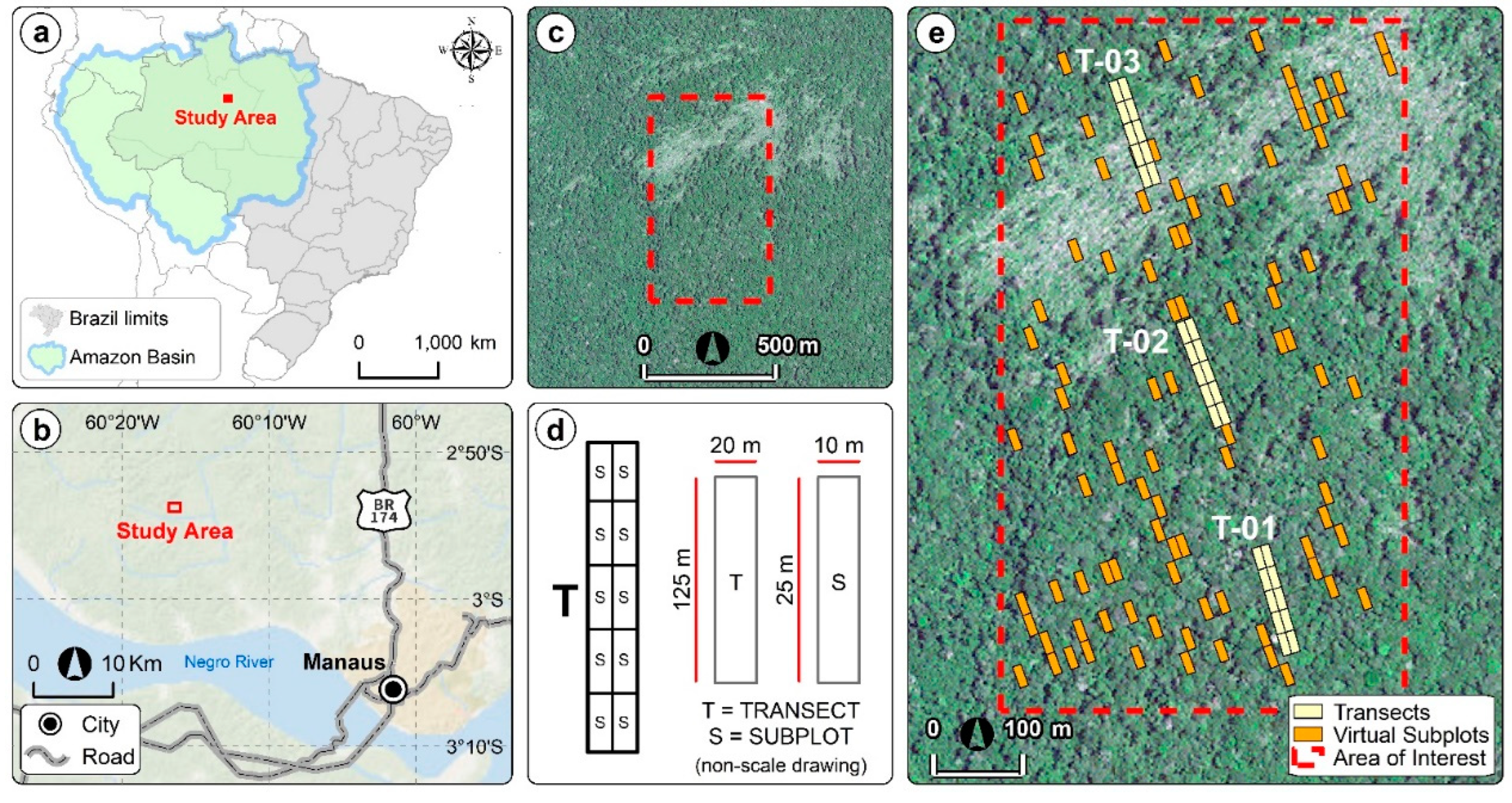
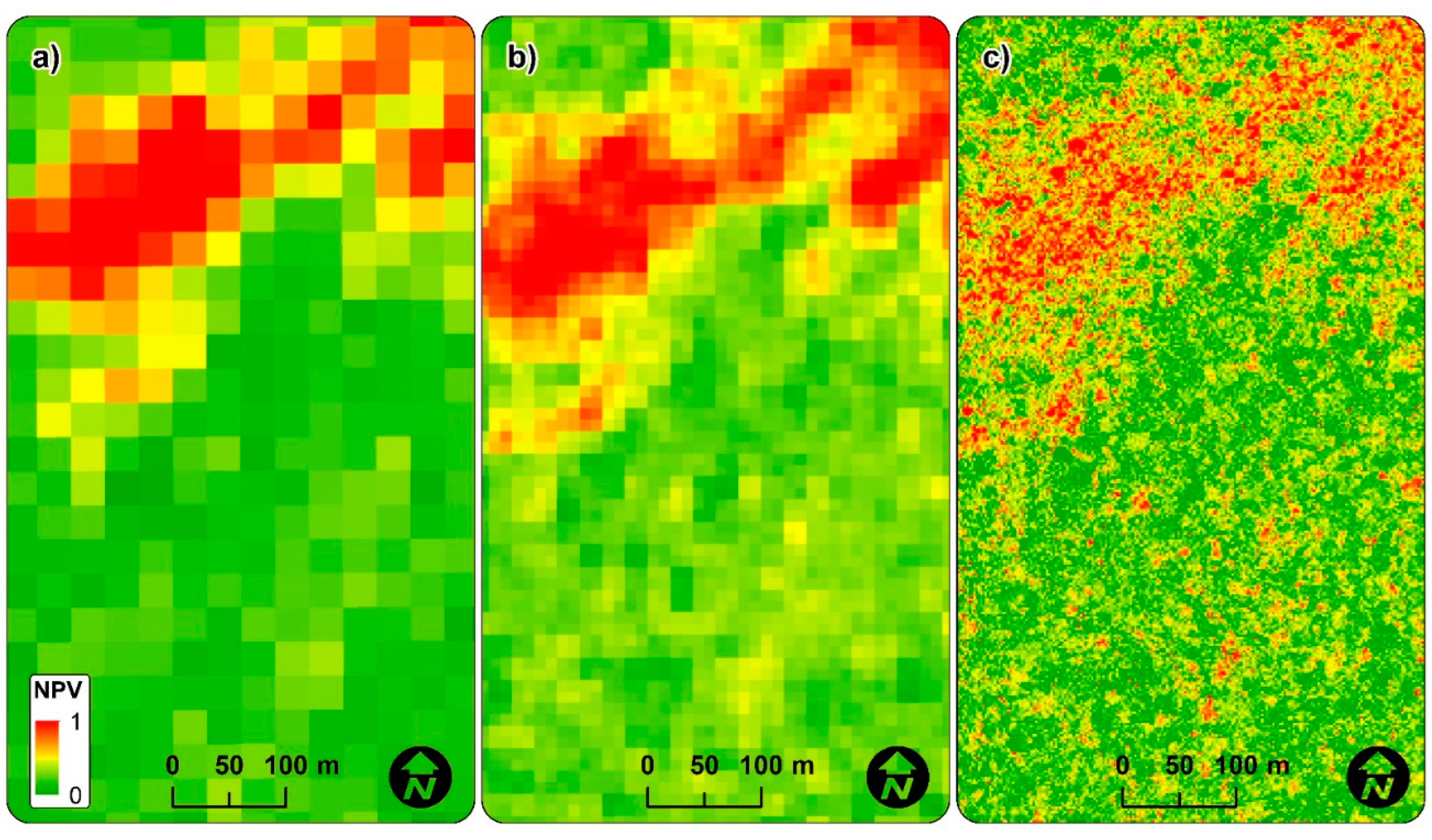
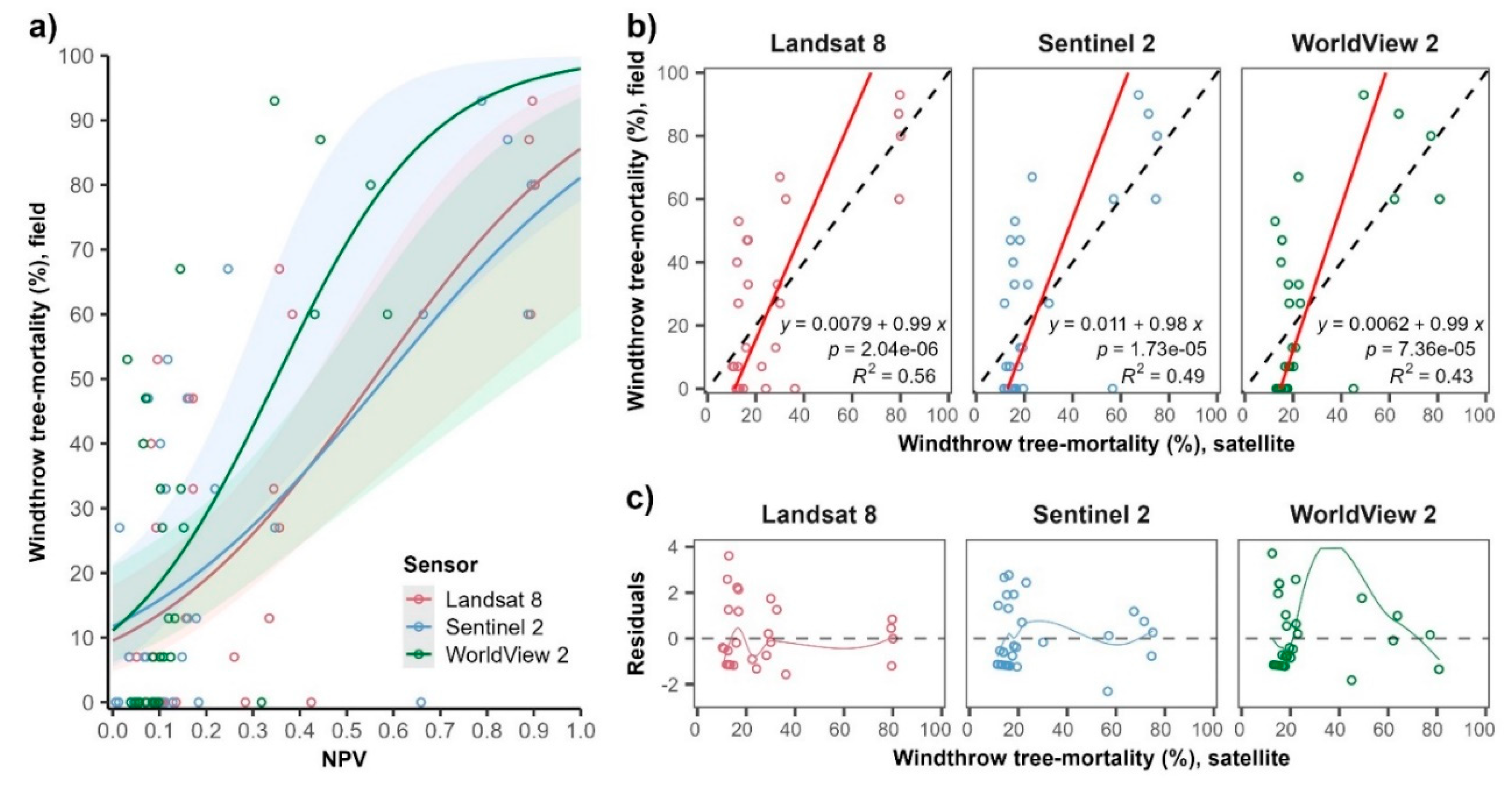
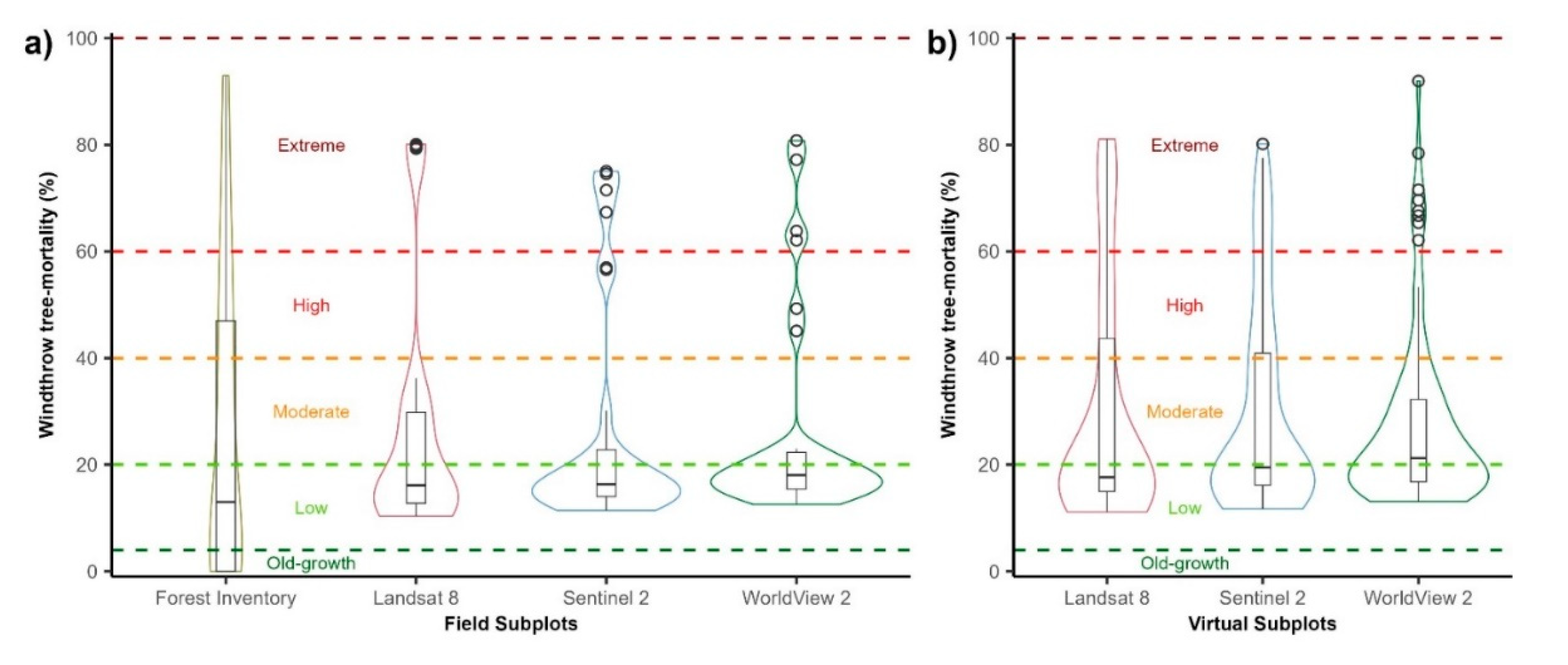
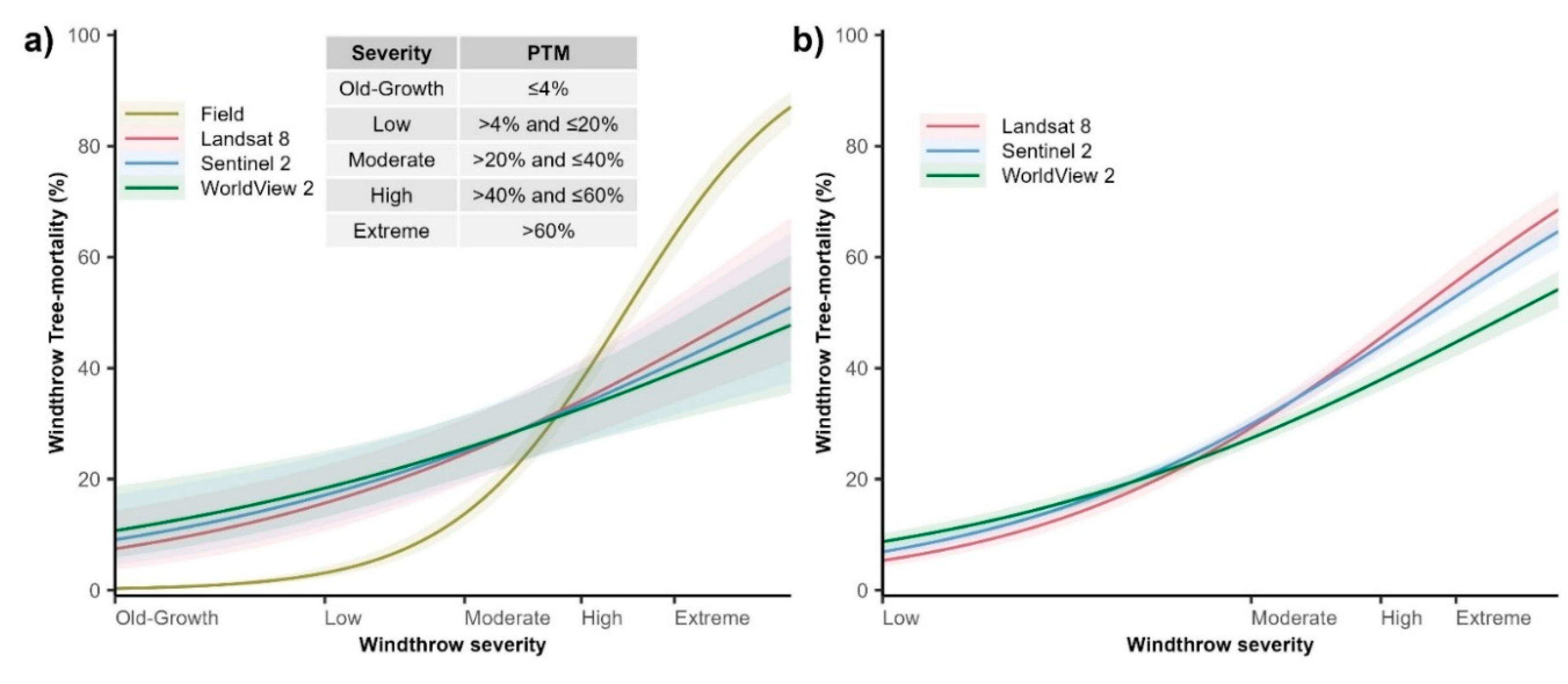
| Model | Residual Deviance | AIC | Syx | RMSE | Sigma | R2;KL | Coefficients | |
|---|---|---|---|---|---|---|---|---|
| a (intercept) | b (slope) | |||||||
| Landsat 8 | 125.33 | 183.37 | 0.2096 | 0.194 | 2.116 | 0.4342 | 9.08 | 0.9837 |
| Sentinel 2 | 136.51 | 194.55 | 0.2211 | 0.209 | 2.208 | 0.3837 | 11.21 | 0.9719 |
| WorldView 2 | 150.01 | 208.05 | 0.2234 | 0.219 | 2.315 | 0.3237 | 10.61 | 0.9977 |
| Subplot type | Measure | Min | Max | Median | Q1 | Q3 | Iqr | Mean | SD | SE | CI |
|---|---|---|---|---|---|---|---|---|---|---|---|
| Field | Field | 0.0 | 93.0 | 13.0 | 0.0 | 47.0 | 47.0 | 26.9 | 29.7 | 5.4 | 11.1 |
| Landsat 8 | 10.3 | 80.1 | 16.1 | 12.8 | 29.8 | 17.0 | 26.5* | 22.5 | 4.1 | 8.4 | |
| Sentinel 2 | 11.4 | 75.0 | 16.3 | 14.0 | 22.8 | 8.8 | 26.5* | 21.2 | 3.9 | 7.9 | |
| WorldView 2 | 12.6 | 80.8 | 18.0 | 15.4 | 22.3 | 6.9 | 26.5* | 19.7 | 3.6 | 7.4 | |
| Virtual | Landsat 8 | 11.1 | 81.1 | 17.6 | 15.0 | 43.7 | 28.7 | 30.2 | 22.1 | 2.2 | 4.4 |
| Sentinel 2 | 11.7 | 80.2 | 19.5 | 16.2 | 40.9 | 24.7 | 30.3 | 19.5 | 1.9 | 3.9 | |
| WorldView 2 | 13.1 | 92.0 | 21.2 | 16.8 | 32.2 | 15.4 | 27.4 | 16.1 | 1.6 | 3.2 |
Disclaimer/Publisher’s Note: The statements, opinions and data contained in all publications are solely those of the individual author(s) and contributor(s) and not of MDPI and/or the editor(s). MDPI and/or the editor(s) disclaim responsibility for any injury to people or property resulting from any ideas, methods, instructions or products referred to in the content. |
© 2023 by the authors. Licensee MDPI, Basel, Switzerland. This article is an open access article distributed under the terms and conditions of the Creative Commons Attribution (CC BY) license (http://creativecommons.org/licenses/by/4.0/).





